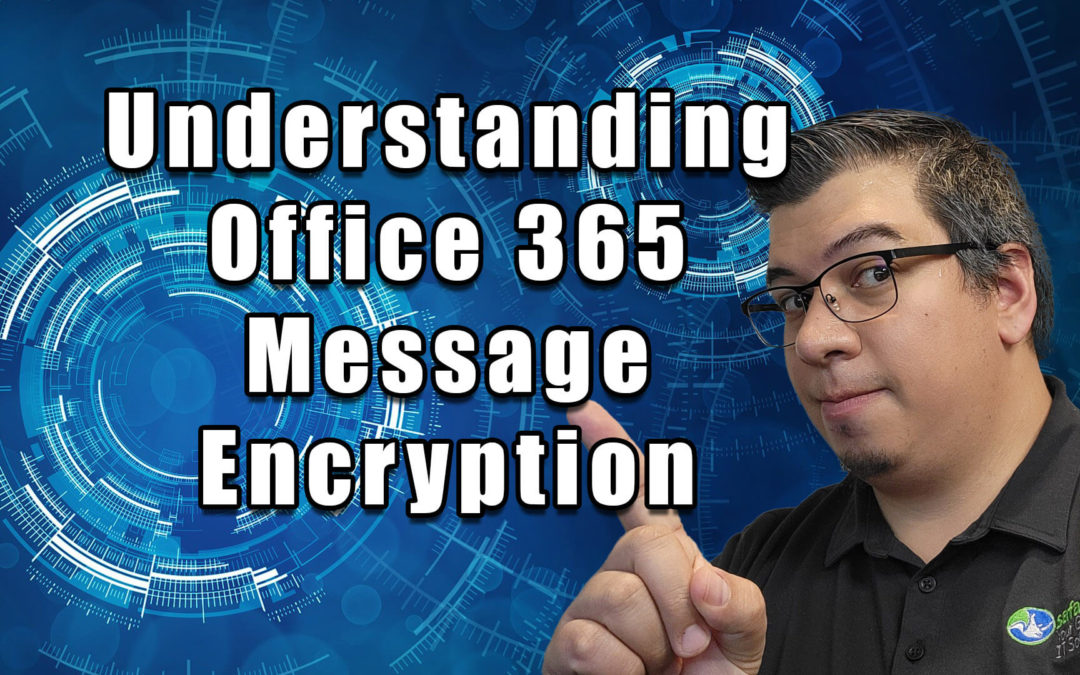In today’s digital landscape, where data breaches and cyber-attacks are increasingly common, ensuring the security of your organization’s communication is paramount. Microsoft has designed a robust solution to this – Office 365 Message Encryption (OME). OME allows users to send and receive encrypted email messages across various platforms and other email services.
What is Office 365 Message Encryption?
Office 365 Message Encryption, grounded in the robust framework of Microsoft Azure Rights Management (Azure RMS), is a comprehensive solution designed to safeguard your email communications. Azure RMS offers a triumvirate of security measures: encryption, identity, and authorization policies, each playing a vital role in protecting your sensitive information.
Encryption, the core of this system, scrambles the content of your messages, making them unreadable to anyone except the intended recipient. This ensures that even if your message falls into the wrong hands, it remains indecipherable and secure.
The identity component of Azure RMS works hand-in-hand with encryption. It verifies the identity of the recipient before granting access, ensuring that only the intended person can decrypt and read the message. This two-step process adds an extra layer of security, making it much harder for unauthorized individuals to gain access to your sensitive information.
Authorization policies, the third pillar of Azure RMS, allow you to control who can do what with your data. For example, you can prevent recipients from forwarding, copying, or printing your emails, offering you a greater degree of control over your information even after it has been sent.
Office 365 Message Encryption gives users the flexibility to choose how they want to secure their communications. They can use rights management templates for predefined settings, the ‘Do Not Forward’ option to prevent onward sharing of the message, or an ‘encrypt-only’ option for straightforward encryption without additional restrictions.
Furthermore, Office 365 Message Encryption extends beyond the Microsoft ecosystem. Users can send encrypted emails across various platforms, including Outlook.com, Yahoo!, Gmail, and other email services. Recipients of these encrypted emails, irrespective of their email client, can view these messages without any additional steps, providing a seamless user experience.
In essence, Office 365 Message Encryption is a versatile and user-friendly solution that provides robust protection for your email communications. Whether you’re an individual looking to secure personal emails or an organization aiming to protect sensitive corporate information, it offers the tools and flexibility to meet your needs.
How does it work?
The operation of Office 365 Message Encryption is rooted in the concept of mail flow rules, also known as transport rules. Admins can define these rules to apply encryption protection, tailoring them to specific organizational requirements.
For instance, a rule could be set to require encryption for emails sent to a specific recipient or those containing certain subject lines. This level of customization adds a layer of automation to the process, improving efficiency and ensuring consistency in email protection.
Imagine a scenario where an organization often sends sensitive data to a particular client. An admin could set a rule that automatically encrypts all emails sent to that client’s address. Similarly, if there are certain keywords associated with sensitive information – like “confidential” or “proprietary” – admins can create a rule that triggers encryption whenever those words appear in an email.
On the other hand, Microsoft Purview Message Encryption offers additional capabilities. For example, it can encrypt replies from recipients of encrypted email, providing end-to-end encryption for the entire conversation.
But the flexibility doesn’t end there. Office 365 Message Encryption allows admins to define flexible conditions that determine when email messages should be encrypted. This means that encryption isn’t just a binary on-or-off setting; instead, it can be dynamically applied based on the context of each email. This adaptability makes it a powerful tool that can cater to varying organizational needs.
For users, this advanced encryption system is seamless. Recipients within an organization can read encrypted messages directly in any version of Outlook. For those using other email clients, such as Gmail or Yahoo, they receive a wrapper mail directing them to the OME Portal or the encrypted message portal, where they can securely view the message.
Furthermore, Microsoft Purview Advanced Message Encryption takes it a step further by allowing multiple branding templates and flexible control over external recipient’s access to encrypted emails. It can detect sensitive information types or keywords to enhance protection, and admins can control message revocation and expiration for emails sent to recipients outside the organization.
The User Experience
One of the most commendable aspects of Office 365 Message Encryption is its commitment to a seamless user experience. Regardless of the email client being used, recipients can effortlessly view protected email messages, ensuring that security measures do not impede communication.
For users within an organization utilizing Outlook clients, the process is exceptionally straightforward. Encrypted emails appear just like any other message in their inbox. They can open and read these protected messages directly in any version of Outlook, whether it’s on the desktop, a mobile device, or the web. This native, first-class reading experience for encrypted and rights-protected mail eliminates the need for additional steps or software, making secure communication as easy as regular email.
The ease of use extends beyond the Microsoft ecosystem. Recipients using other email clients, such as Gmail and Yahoo, are also catered to. When they receive an encrypted message, they get a wrapper email. This email serves as a secure envelope that contains a link directing them to the Office 365 Message Encryption (OME) Portal.
The OME Portal is a secure platform designed specifically for viewing encrypted messages. Here, recipients can authenticate themselves to ensure they are the intended receivers of the message. The authentication process can be done through a one-time passcode sent to their email or by signing in with a Google, Microsoft, or Yahoo account. Once authenticated, they can read the message securely within the portal.
Moreover, the OME Portal isn’t just for reading messages. It also allows recipients to reply securely, ensuring that the entire conversation remains encrypted and protected. This feature is particularly beneficial for ongoing threads containing sensitive information.
In Government Community Cloud High (GCC High), recipients are served in a similar fashion. They receive a wrapper email that directs them to the encrypted message portal, where they can securely view their message after authentication.
Advanced Message Encryption
For organizations that need a higher degree of customization and control over their encrypted emails, Microsoft offers Purview Advanced Message Encryption. This sophisticated feature set is designed to provide granular control, allowing for a more tailored approach to email security.
One of the standout features of Purview Advanced Message Encryption is its support for multiple branding templates. This means that organizations can maintain their brand identity consistently across all communications, even when these messages are encrypted. Whether you want to include your logo, company color scheme, or specific messaging, these branding templates allow you to customize the appearance of your encrypted emails, enhancing the professional image of your organization.
Moreover, Purview Advanced Message Encryption provides flexible control over external recipient access to encrypted emails. This is particularly useful when sending sensitive information to recipients outside the organization. Admins can manage who has access to what information, ensuring that only the right individuals have access to the right data.
But the control doesn’t end there. Purview Advanced Message Encryption also includes features like expiring access and revoking access to encrypted emails. The expiring access feature allows admins to set a time limit on access to an encrypted email. Once the set time elapses, the recipient can no longer view the email content, enhancing data security. The revoking access feature gives admins the power to immediately withdraw access to an encrypted email, regardless of whether the recipient has already opened it. These features offer enhanced control over sensitive information, even after it has been sent.
It’s important to note that message revocation and expiration only work for emails sent to recipients outside the organization and accessed through the web portal. While this might seem limiting, it’s actually a strategic decision. It ensures that internal communications remain accessible for business continuity, while still providing stringent controls for external communications where the risk of data leakage is higher.
Setting Up Office 365 Message Encryption
Setting up Office 365 Message Encryption is a straightforward process. Exchange Online and Exchange Online Protection administrators can enable it by defining mail flow rules. Admins can set up these rules in Microsoft 365 to automatically encrypt emails based on keyword matching or other conditions.
Office 365 Message Encryption is a powerful tool that offers robust email protection without compromising on user experience. Whether you’re an individual concerned about the privacy of your communication or an organization looking to safeguard sensitive information, Office 365 Message Encryption provides a comprehensive and user-friendly solution.
Remember, in our interconnected world, data protection should always be a priority. Stay safe and keep your communications secure with Office 365 Message Encryption!

